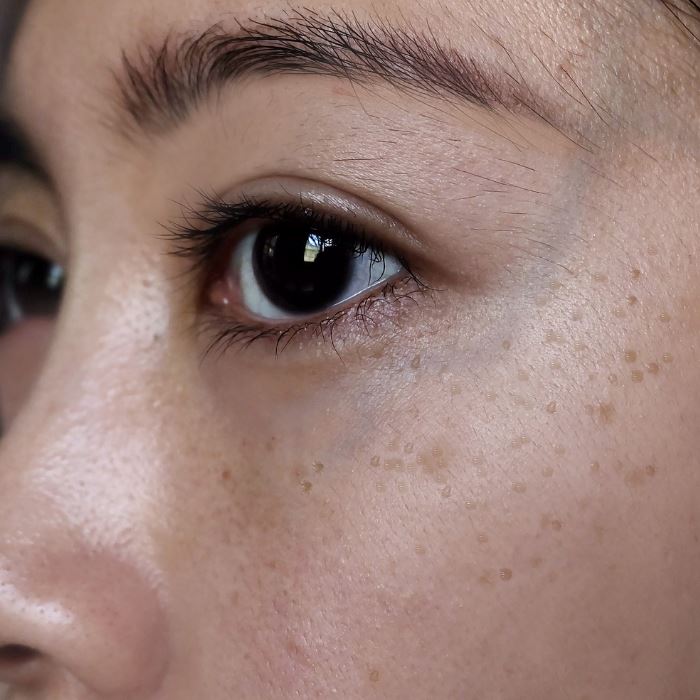Everything you need to know about skin hyperpigmentation

Topicrem celebrates its 30th anniversary!
0,00€
Skin pigmentation is the natural biological process of coloring our skin. When it is well regulated, our complexion is beautiful and uniform. But now, the mechanics can break down and cause the appearance of spots also called hyperpigmentation.
In this article, we explain everything about the different types of skin hyperpigmentation, their causes and origins, their characteristics, their locations and above all, we give you our best advice to prevent them and reduce their appearance.
We owe the color of our skin to its natural pigmentation process provided by a specialized cell located in the epidermis, the melanocyte.
This melanocyte produces melanin, a mixture of different skin pigments:
Each individual therefore has these pigments in very variable proportions, making our complexion a unique characteristic.
Once produced by the melanocyte in small bags called melanosomes, melanin is then transferred from the deeper layers of the epidermis to cells called keratinocytes.
Thanks to the cellular renewal of keratinocytes, melanin progresses to the surface of the skin and colors it.
When tanning, the entire skin pigmentation process is activated by UV rays.
To find out more about the effects of the sun on the skin , find our dedicated article.

Hyperpigmentation is a pigmentary disorder linked to excessive production of melanin by the melanocyte, in certain areas of the face and body.
Pigmentary disorders are common, and there are different types that can appear locally, like spots or moles, but also on a large scale like the mask of pregnancy, the famous melasma.
There is a wide variety of skin hyperpigmentations, each with its own characteristics ¹ - ³ .
This is the medical term for spots induced by sun exposure and includes both age spots (senile lentigos) and sun spots (solar lentigos). Lentigo is localized hyperpigmentation, common on areas exposed to the sun such as the face, hands, and neckline. Light brown to black in color, lentigo occurs mainly from the age of 40 but can also appear earlier. Lentigo affects all skin types but particularly fair skin.
Also called chloasma or more commonly “pregnancy mask”, the surprise guest for future mothers! Melasma is essentially of hormonal origin and manifests itself especially during pregnancy in the form of large dark areas on the face, on the cheeks, the nose, the forehead or between the nose and the mouth. This hyperpigmentation is very common in women, but can also occur in men.
Also called post-inflammatory hyperpigmentation. You have probably already noticed the appearance of hyperpigmentation on your skin after an injury such as a scar, a cut, an acne spot, a surgical procedure, etc. This is post-inflammatory hyperpigmentation. which turn brown generally after the inflammatory phase during which the skin is red then pink. These are spots that appear very frequently in darker skin tones.
Due to their high melanin density, dark phototypes may more frequently present pigmentation disorders.
The areas most affected are those around the eyes with dark circles, or even joint areas such as the elbows and knees.

If your skin is prone to spots, then you probably know that pigmentation disorders can cause real discomfort on a daily basis. Scientific studies have highlighted a negative impact of different types of hyperpigmentation on quality of life, but also particularly significant psychological and emotional distress among dark phototypes (IV, V, VI).
Acne and post-inflammatory hyperpigmentation are also shown in studies to be sources of embarrassment with a significant psychosocial impact for those affected ⁴ .
To help you understand where your pigmentation disorders may come from, here are the most common causes of skin hyperpigmentation⁵.
Melanin is primarily a way for the skin to protect itself from sun damage. This is why UV rays directly stimulate the activity of the melanocyte and activate the overproduction of melanin. Intense and prolonged exposure to the sun overstimulates the skin's pigmentation process, and promotes hyperpigmentation in exposed areas.
Several hormones play a role in skin pigmentation by stimulating the melanocyte to produce melanin. Among these hormones, we find estrogens, α-MSH, MSH, etc. These hormones can promote the appearance of pigmentation disorders, such as melasma (or chloasma) during pregnancy or even menopause. The birth control pill or hormone replacement therapy can also promote melasma.

Naturally with age, the skin pigmentation process slows down. If the number of melanocytes in the epidermis decreases, the production of melanin is, on the other hand, increased. Melanin is also distributed less well in the skin, which leads to the appearance of spots or hyperpigmented areas.
Our skin can experience different episodes of inflammation that are more or less punctual or chronic. This is particularly the case with acne, during injuries (cuts, burns, etc.), or during healing phases where it is common for scars to become hyperpigmented. Skin prone to atopic dermatitis can also show hyperpigmentation.
Our skin color is induced by our genetics. So, depending on your phototype (type of skin tone), you may be more or less predisposed to hyperpigmentation. This is the case for dark skin (phototypes IV, V and VI) which are more prone to pigmentation disorders.
Antibiotics, antiepileptics, or even chemotherapy can promote pigmentation disorders. Diseases are also known for their effects on pigmentation such as vitiligo characterized by localized loss of melanocytes, albinism, atopic dermatitis, hemochromatosis (excess iron in the body), gastrointestinal diseases (syndrome of Peuz-Jeghers), hormonal diseases (Addison's disease), or even neurological diseases (neurofibromatosis). Nutrient deficiencies can also cause pigmentation disorders such as vitamin C deficiency, folate/B12 deficiency, or vitamin A deficiency...
Hyperpigmentation can appear all over the body and face.
But depending on the types of hyperpigmentation, certain areas are more prone to pigmentation disorders such as the face, neck and décolleté, and hands.
As you will have understood, the areas most exposed to the sun are more likely to be affected.
Hyperpigmentation can also be more or less extensive. If lentigo is mainly characterized by small localized spots, melasma can impact large areas of the face such as the forehead and cheeks.
To help you take care of your skin prone to spots and hyperpigmentation, here are our best tips.
At home, you can apply topical cosmetic treatments designed to act on pigmentation disorders. These treatments use active ingredients capable of reducing the appearance of spots by regulating the production of melanin at several levels. Here are some of the most famous cosmetic ingredients against spots and hyperpigmentations ⁶- ⁹.

Vitamin C: this powerful antioxidant intervenes by inhibiting the enzyme responsible for the production of melanin. Vitamin C is known for its targeted action on pigmentation spots.
Niacinamide, or vitamin B3: this active ingredient with anti-inflammatory and antioxidant properties reduces hyperpigmentation and improves the uniformity of the complexion by limiting the transfer of melanin to keratinocytes, the cells of the epidermis.
Plant extracts: there are also many plants that have clinically demonstrated lightening properties on skin pigmentation, such as certain algae extracts, licorice, schisandre berries, bearberry, etc.
To actively fight against spots and different types of hyperpigmentation, at TOPICREM, we have developed and patented a unique complex of ingredients against spots. Our MELA Complex is composed of niacinamide and an algae extract which act on all stages of melanogenesis for optimal unifying action.
To find out more about our MELA Complex, click here .
Our final advice to be effective on skin hyperpigmentation, your anti-spot cosmetic treatment must be accompanied by good UV protection. Otherwise, UV rays will naturally stimulate melanin production.

Remember, the sun is an important factor causing hyperpigmentation of the skin. To limit the appearance of pigmentary disorders, it is therefore essential to protect your skin daily against UV rays.
Protective treatments with high protection indices SPF 30 or SPF 50, or even SPF 50+ can be applied in addition to your daily skincare routine for optimal protection.
Ideally, it is necessary to renew the application during the day, especially if you live in very sunny areas.
In their office, dermatologists practice treatments capable of reducing skin hyperpigmentation¹⁰-¹²
TOPICREM formulas have all been designed with the aim of providing protective hydration and preserving the skin barrier of sensitive skin for the whole family.
To do this, our laboratory relies on its expertise derived from pharmaceutical excellence:
Selection of high tolerance ingredients with proven effectiveness,
Development of clinically tested formulas on sensitive skin,
Effectiveness proven by science and approved by consumers.
Through the comfort and emotional well-being they provide, our treatments help you feel confident with your skin and with yourself, to better reveal yourself to others, and thus to fully enjoy every moment of life. .
Bibliographic references:
[1] NA Vashi and RV Kundu, “Facial Hyperpigmentation: Causes and Treatment”, British Journal of Dermatology 169, no s3, 2013.
[2] Thierry Passeron and Mauro Picardo, “Melasma, a Photoaging Disorder”, Pigment Cell & Melanoma Research 31, no 4 (2018): 461‐65.
[3] Erica C. Davis and Valerie D. Callender, “Postinflammatory Hyperpigmentation: A Review of the Epidemiology, Clinical Features, and Treatment Options in Skin of Color,” The Journal of Clinical and Aesthetic Dermatology 3, no. 7 (July 2010) : 20‐31.
[4] Barbara Schuster, Julia Gallinger, Wolfgang G Philipp-Dormston, Matthäus Vasel, Alison M Layton, Less confident, successful and happy: patients with post-acne hyperpigmentation are stigmatized, British Journal of Dermatology, Volume 188, Issue 5, May 2023, Pages 682–684, https://doi.org/10.1093/bjd/ljad026
[5] NA Vashi and RV Kundu, “Facial Hyperpigmentation: Causes and Treatment”, British Journal of Dermatology 169, no s3, 2013.
[6] T. Hakozaki et al., “The Effect of Niacinamide on Reducing Cutaneous Pigmentation and Suppression of Melanosome Transfer”, The British Journal of Dermatology 147, no 1 (July 2002): 20‐31.
[7] Migan, “Study of depigmenting agents and their misuse in voluntary depigmentation”, 2013.
[8] CK Kimbrough-Green et al., “Topical Retinoic Acid (Tretinoin) for Melasma in Black Patients.” A Vehicle-Controlled Clinical Trial,” Archives of Dermatology 130, no. 6 (June 1994): 727‐33.
[9] Rathee, P., Kumar, S., Kumar, D., Kumari, B., & Yadav, S. (2021). Skin hyperpigmentation and its treatment with herbs: an alternative method. Future Journal of Pharmaceutical Sciences, 7. https://doi.org/10.1186/s43094-021-00284-6.
[10] Barry Ladizinski, Nisha Mistry, and Roopal V. Kundu, “Widespread Use of Toxic Skin Lightening Compounds: Medical and Psychosocial Aspects,” Dermatologic Clinics, Special Topics in Tropical Dermatology, 29, no 1 (January 1, 2011): 111 -23.
[11] Nautiyal, A., & Wairkar, S. (2021). Management of hyperpigmentation: Current treatments and emerging therapies. Pigment Cell & Melanoma Research, 34, 1000 - 1014. https://doi.org/10.1111/pcmr.12986.
[12] Akiko Usuki et al., “The Inhibitory Effect of Glycolic Acid and Lactic Acid on Melanin Synthesis in Melanoma Cells,” Experimental Dermatology 12 Suppl 2 (2003): 43‐50.

How to choose the right moisturizer for your skin type? Topicrem supports you in finding a pleasa...
Read the article
You no longer know which TOPICREM to choose? Explore our various dermo-cosmetic treatments and th...
Read the article
If you want to spend more time with your skin, TOPICREM has a few tips for an uncomplicated routi...
Read the article
Discover how this simple ritual can enhance your skin, revealing its natural luminosity. From eli...
Read the article



